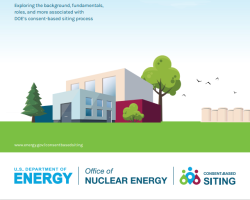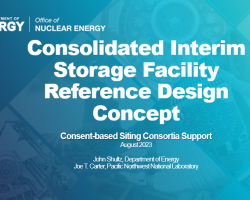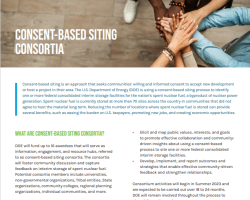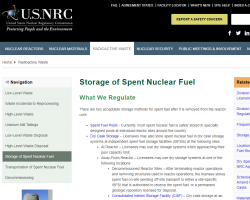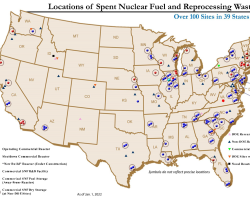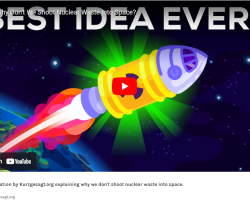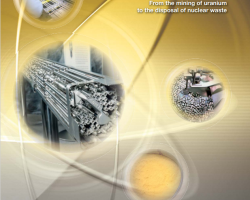Category of Content
Siting Experience Documents Only
Publication Date
Subject Matter
Keywords
Consent-Based Siting Process for Federal Consolidated Interim Storage of Spent Nuclear Fuel
Consent-Based Siting Process for Federal Consolidated Interim Storage of Spent Nuclear Fuel
In this document, the U.S. Department of Energy (DOE) outlines its road map for implementing a consent-based siting process to site one or more federal consolidated interim storage facilities for spent nuclear fuel.
Research Supporting Implementation of Burnup Credit in the Criticality Safety Assessment of Transport and Storage Casks
Research Supporting Implementation of Burnup Credit in the Criticality Safety Assessment of Transport and Storage Casks
Radiolytic Specie Generation from Internal Waste Package Criticality
Radiolytic Specie Generation from Internal Waste Package Criticality
Intact and Degrade Mode Criticality Calculations for the Codisposal of TMI-2 Spent Nuclear Fuel in a Waste Package
Intact and Degrade Mode Criticality Calculations for the Codisposal of TMI-2 Spent Nuclear Fuel in a Waste Package
SCALE-4 Analysis of Pressurized Water Reactor Critical Configurations: Volume 3-Surry Unit 1 Cycle 2
SCALE-4 Analysis of Pressurized Water Reactor Critical Configurations: Volume 3-Surry Unit 1 Cycle 2
Science based responses to social myths on nuclear energy
Science based responses to social myths on nuclear energy
In order to promote a sound basis for considering the role of nuclear in climate change, this review spans the technical topics of social and political debate surrounding nuclear energy with a focus on the objective science of these issues including nuclear waste, accidents and overall risk. Novel aspects include the emergence of nuclear energy as being potentially renewable and the antithesis of Fukushima being an argument for the unacceptable risks associated with the use of nuclear energy.
Probabilistic External Criticality Evaluation
Probabilistic External Criticality Evaluation
The Likelihood of Criticality Following Disposal of SF/HLW/HEU/Pu
The Likelihood of Criticality Following Disposal of SF/HLW/HEU/Pu
Supplement to the Disposal Criticality Analysis Methodology
Supplement to the Disposal Criticality Analysis Methodology
Screening Analysis of Criticality Features, Events, and Processes for License Application
Screening Analysis of Criticality Features, Events, and Processes for License Application
Survey of National Programs for Managing High-Level Radioactive Waste and Spent Nuclear Fuel: 2022 Update
Survey of National Programs for Managing High-Level Radioactive Waste and Spent Nuclear Fuel: 2022 Update
In October 2009, the U.S. Nuclear Waste Technical Review Board (Board or NWTRB) published Survey of National Programs for Managing High-Level Radioactive Waste and Spent Nuclear Fuel. For each of the 13 national programs studied, the report catalogued 15 institutional arrangements that had been set in place and 15 technical approaches that had been taken to design repository systems for the long-term management of high-activity radioactive waste.
Comments on the Draft Consent-Based Siting Report and ECA Recommendations
Comments on the Draft Consent-Based Siting Report and ECA Recommendations
Comments on behalf of Energy Communities Alliance submitted to the U.S. Department of Energy on Draft Consent-Based Siting Process for Consolidated Storage and Disposal Facilities for Spent Nuclear Fuel and High-Level Radioactive Waste.
A Community Handbook on Nuclear Energy
A Community Handbook on Nuclear Energy
This handbook was prepared by Energy Communities Alliance (ECA) with funding from the U.S. Department of Energy (DOE), Office of Nuclear Energy, under Cooperative Agreement DE-NE0000006. It does not represent the views of the Department of Energy, and no official endorsement should be inferred. This handbook is an update to the version originally released in March 2012. The authors are Kara Colton, Allison Doman and Seth Kirshenberg of ECA.
Helping a Community Control its Future: Potential Negotiating Packages and Benefits for an MRS Host
Helping a Community Control its Future: Potential Negotiating Packages and Benefits for an MRS Host
The voluntary siting process for the Monitored Retrievable Storage (MRS) facility set forth in the Nuclear Waste Policy Amendments Act (NWPAA) of 1987 provides a potential host community a unique opportunity to improve its present situation and to gain greater control over its future.
Consolidated Interim Storage Facility Reference Design Concept
Consolidated Interim Storage Facility Reference Design Concept
Presentation slides on the Consolidated Interim Storage Facility Reference Design Concept, including site plans; handling, inspection and repackaging concepts and facilities; and cost and staffing estimates.
Summary of Consolidated Interim Storage Advantages and Disadvantages from an Integrated Systems Perspective from Prior Reports and Studies
Summary of Consolidated Interim Storage Advantages and Disadvantages from an Integrated Systems Perspective from Prior Reports and Studies
The question of whether centralized storage of civilian spent nuclear fuel (SNF) should be part of the federal waste management system as an intermediate step before permanent disposal has been debated for more than four decades. Centralized storage facilities were included as a potential component of the U.S. spent fuel management system in the Nuclear Waste Policy Act of 1982 (NWPA), but the NWPA did not identify these facilities as being essential.
Consent-Based Siting Consortia flyer
Consent-Based Siting Consortia flyer
Consent-based siting is an approach that seeks communities’ willing and informed consent to accept new development or host a project in their area. The U.S. Department of Energy (DOE) is using a consent-based siting process to identify one or more federal consolidated interim storage facilities for the nation’s spent nuclear fuel, a byproduct of nuclear power generation. Spent nuclear fuel is currently stored at more than 70 sites across the country in communities that did not agree to host the material long term.
NRC Online Resources - Storage of Spent Nuclear Fuel Webpage
NRC Online Resources - Storage of Spent Nuclear Fuel Webpage
NRC's "Storage of Spent Nuclear Fuel" includes a short discussion of "What We Regulate"; "How We Regulate"; and links to related information.
Consent-Based Siting flyer
Consent-Based Siting flyer
What is Consent-Based Siting?
Consent-based siting is an approach that seeks the willing and informed consent of people and communities to host a project in their area. This process is designed to be flexible, adaptive, and responsive to community concerns.
How is DOE using Consent-Based Siting? How can people and communities participate?
Spent Nuclear Fuel and Reprocessing Waste Inventory, Revision 9
Spent Nuclear Fuel and Reprocessing Waste Inventory, Revision 9
This report provides information on the inventory of spent nuclear fuel (SNF) in the United States located at Nuclear Power Reactor and Independent Spent Fuel Storage Installation sites, as well as SNF and reprocessing waste located at U.S. Department of Energy sites and other research and development centers as of the end of calendar year 2021.
Spending Time on Spent Nuclear Fuel
Spending Time on Spent Nuclear Fuel
Making progress on the long-term management of spent nuclear fuel can be fraught with political and economic challenges, but groups within the U.S. are looking to try and tackle the challenge from many different angles. As the government ramps up efforts to support spent nuclear fuel management up to the limits of the law, ANS and others are making recommendations around, and receiving funding oriented to, pathways for progress.
3 Reasons Why We Don’t Launch Nuclear Waste into Space
3 Reasons Why We Don’t Launch Nuclear Waste into Space
A viral YouTube video recently discussed the age-old question “why don’t we shoot nuclear waste into space?”
It’s a topic we often get asked about on social media.
While the educational video’s cartoonish depictions of nuclear waste as glowing green ooze made some of our subject matter experts cringe, it’s clear that the content creators did their homework.
Getting to the Core of the Nuclear Fuel Cycle: From the mining of uranium to the disposal of nuclear waste
Getting to the Core of the Nuclear Fuel Cycle: From the mining of uranium to the disposal of nuclear waste
This brochure shortly describes the various steps of the nuclear fuel cycle by covering areas from mining and milling to disposal of spent fuel and other radioactive waste.
Status and Trends in Spent Fuel and Radioactive Waste Management
Status and Trends in Spent Fuel and Radioactive Waste Management
Status and Trends in Spent Fuel and Radioactive Waste Management is a collaborative project between the IAEA, the European Commission and the OECD Nuclear Energy Agency, with the participation of nuclear industry organization the World Nuclear Association, that aims to consolidate and complement the information gathered from different initiatives around the world.
